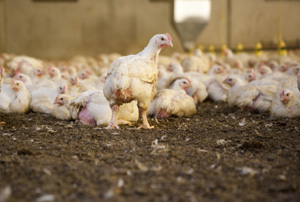Sustainability is what counts!

The global poultry industry is facing the challenge of meeting an increasing demand for healthy proteins of animal origin and to produce it in an animal friendly and sustainable manner at an affordable price. Researchers at the European Symposium on the Quality of Egg and Meat Products showed that progress is being made.
By Wiebe van der Sluis
Globally animal production is facing many challenges to meet the expected increase in consumption of proteins of animal origin by a growing population. With this message Dr Caspar Wenk, nutrition biologist at ETH in Zürich, Switzerland gave the recent XIV European Symposium on the Quality of Eggs and Egg products and the XX European Symposium on the Quality of Poultry Meat in Leipzig an energetic kick-off.
He warned 250 researchers present, all members of the World’s Poultry Science Association from all over the world, that within the next forty years earth will have to provide milk, meat and eggs for twice as many people as today. Meanwhile the per capita consumption for these foodstuffs will increase. This expanding demand, Wenk added, must be achieved with limited resources including available land, energy, water and nutrients. The increase in production must therefore include all aspects of sustainability (human, economic and ecological).
To achieve these goals the main challenge in animal production according to Wenk, is an increase of the efficiency at all levels of the food chain. Basic preconditions are healthy animals that enable a high fertility, longevity and performance. The requirements of all essential nutrients must be covered according to the genetic potential of the animals.
Food industry by-products
Overfeeding with environmentally critical nutrients must be avoided, Wenk continued. “There are big differences in the energy and nutritional utilisation as well as environmental loads between animal species, of which modern poultry breeds prove to be highly efficient. But high performing animals require feed of high quality that also could be used for human consumption. Therefore a balance in the use of food between man and animals must be reconsidered again and again.”
Overfeeding with environmentally critical nutrients must be avoided, Wenk continued. “There are big differences in the energy and nutritional utilisation as well as environmental loads between animal species, of which modern poultry breeds prove to be highly efficient. But high performing animals require feed of high quality that also could be used for human consumption. Therefore a balance in the use of food between man and animals must be reconsidered again and again.”
The increase in performance of farm animals also contributes significantly to an efficient utilisation of recourses and helps, according to Wenk, to reduce the environmental load per unit product. This can mainly be explained by the fact that in fast growing birds, one unit of lean meat requires four times less energy than one unit of adipose tissue.
The use of by-products from the food industry helps for a sustainable animal production, if they are adequate for the animal species used. Hygienic and toxicological aspects as well as possible effects on food quality must be considered. Within this context no one can afford to waste billions of Euros by destroying valuable nutrients like meat and bone meal and phosphorus.
Feed additives can contribute to increased nutrient utilisation and therefore help also to cover the nutrient requirements and boost the health of animals. Wenk concluded his introductory speech by saying that with acceptable animal housing systems and the correct treatment of animal excrements a major contribution to an environmentally sound production can be achieved.
A better image for eggs
During the symposium quite a number of presentations focused on food safety, especially the safety of eggs. Dr Songül Yalçin from the paediatrics department of the Hacettepe University in Turkey told that it is time to give eggs a better image. She underlined that eggs are an excellent nutrient for young children. Supporting this opinion, French researcher Sophie Réhault-Godbert stated that eggs contain hundreds of unknown elements that may revalue egg consumption.
During the symposium quite a number of presentations focused on food safety, especially the safety of eggs. Dr Songül Yalçin from the paediatrics department of the Hacettepe University in Turkey told that it is time to give eggs a better image. She underlined that eggs are an excellent nutrient for young children. Supporting this opinion, French researcher Sophie Réhault-Godbert stated that eggs contain hundreds of unknown elements that may revalue egg consumption.
Yalçin stated that too many children and pregnant women suffer from micronutrient deficiencies, like vitamin A,-B, and D, iron, zinc, iodine and calcium. Under-nutrition of these micronutrients may result in maternal mortality and low birth weight. Iron deficiency in children results in cognitive impairment and anaemia in pregnancy. Yalçin therefore recommended daily egg supply as a complementary food to decrease under-nutrition in children, even more when those eggs are enriched with the most important micronutrients.
Salmonella control
The biggest threat for the image of eggs is the presence of salmonella enteritidis (SE) in some layer flocks. Various speakers showed that progress is being made in controlling the infection, but still there is a lot to be done. Dr Koen de Reu and his colleague Dr Sakia Leleu from the Institute for Agricultural and Fisheries Research (ILVO) in Belgium, gave a number of presentations covering various aspects of spreading and detection of SE. De Reu investigated why, despite the vaccination of layer hens against SE, infected eggs still can be found. He revealed that these infections may originate from the environment.
The prevalence of SE on layer farms is relatively high in the hen house but even more so in the egg collecting area, especially at the end of the laying period. Despite cleaning and disinfection, the egg collecting area remains to be an important source of persisting contamination. Also the floor, manure belts, equipment, flies, red mites, rats and mice were recognised as causing recurrent contamination. Leleu revealed that the presence of microcracks in egg shells did not significantly affect the occurrence of bacterial ingress, although this depends on the eggs’ origin. To better protect eggs against salmonella infections, Larb Bedrani of INRA, France, suggests to immune-challenge hens because it may improve the egg’s chemical protection by modulating the antimicrobial compound activities in egg whites.
Maureen Bain of the University of Glasgow, Scotland, told that eggs from non-cage systems have been described as having a higher bacterial load compared to those laid in conventional cages. Here egg washing and other methods of decontamination can play a role in improving the hygienic properties of eggs. Dr Bain expressed that the continued development of new on-line sensor technologies will significantly contribute to optimising egg quality and safety in non-cage systems by both removing risky eggs during grading but also by providing real time feedback to producers on the health and status of individual flocks.
Campylobacter inactivation
Where Salmonella contamination was the main issue in eggs, in meat several presentations involved ways to reduce campylobacter levels. French researcher Gilles Salvat gave an excellent overview of disinfection of poultry carcasses. There is little new in this field of science, which made Salvat repeat what has been known for long that chlorine based treatments, organic acids and phosphates are the most credible solutions considering both efficiency and economical purpose. When used at the right dose, these chemicals are able to extend shelf life and prevent over contamination of poultry meat with foodborne pathogens.
Where Salmonella contamination was the main issue in eggs, in meat several presentations involved ways to reduce campylobacter levels. French researcher Gilles Salvat gave an excellent overview of disinfection of poultry carcasses. There is little new in this field of science, which made Salvat repeat what has been known for long that chlorine based treatments, organic acids and phosphates are the most credible solutions considering both efficiency and economical purpose. When used at the right dose, these chemicals are able to extend shelf life and prevent over contamination of poultry meat with foodborne pathogens.
Nevertheless he stated that when authorising a large use of these chemicals, their effects – benefits or adverse – on the ecological balance of the microbial flora of meat will have to be taken into consideration. A more natural image than the use of chlorine or irradiation to inactivate Campylobacter was suggested by Aline Chaine of CIRAD, La Réunion, France. She looked at steam and acid treatments and concluded that both are good candidates as their efficiency has also been shown on other pathogens.
Researchers at the University of Bologna, Italy, showed that free range broilers have a lower load of mesophylic bacteria, Enterobacteriaceae and Campylobacter spp than conventionally reared broilers. However this difference was not confirmed after evisceration, highlighting the relevance of this step as a possible-cross contamination phase.
Alternative nutrients ince feed prices are on the rise there is an increasing interest in using alternative ingredients. Finnish researchers looked at the possibilities of peas and rapeseed and concluded that a rapeseed only diet is not suitable for broilers. It showed a negative effect on bird performance and mortality, although it clearly improved the fatty acid profile of the meat. However mixing rapeseed with peas will reduce the negative effects. A.A. El-Deek of Saudi Arabia showed that date waste can also be used in broiler diets for up to 21% without any bad effect on the productive performance of birds from 7-35 day of age. After conducting a second trial he concluded that date waste supplemented with enzymes and probiotics could be included in broiler diets up to 15% during the period from 15-42 days to achieve optimum broiler performance. Flax seeds are rich in omega-3 and are commonly used in animal diets with good meat enriching performances. The negative effect of enriching meat with “good for health” unsaturated fatty acids is that these compounds are highly susceptible to oxidation which generates “bad for health” degradation molecules, such as pro-oxidant free radicals. To avoid these reactions, omega-3 are generally coupled with an antioxidant. The classical antioxidant in animal diet is vitamin E and previous studies have shown its efficacy in preventing lipid oxidation in poultry muscles. |













